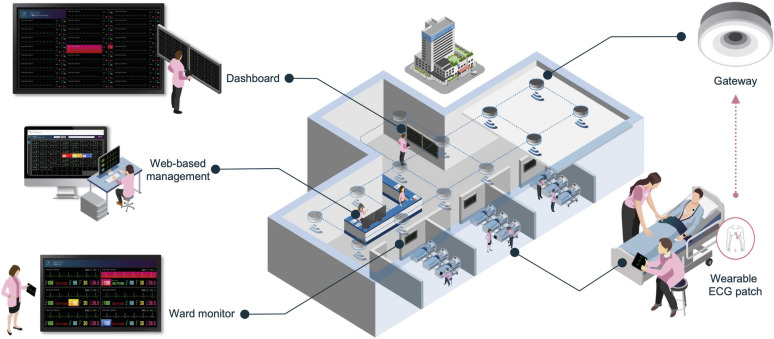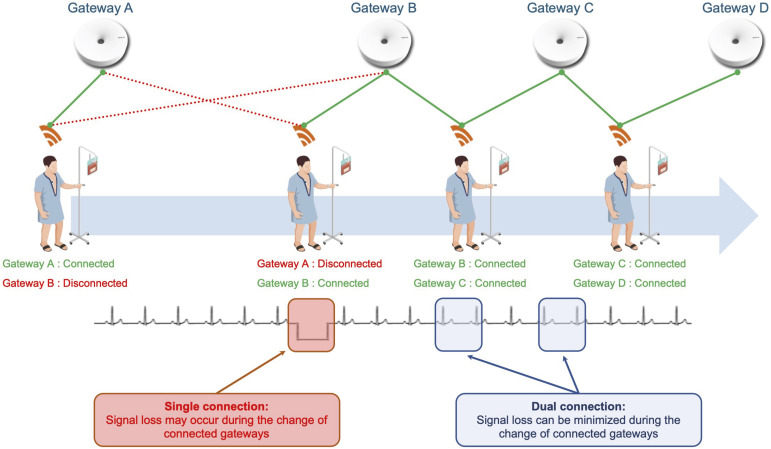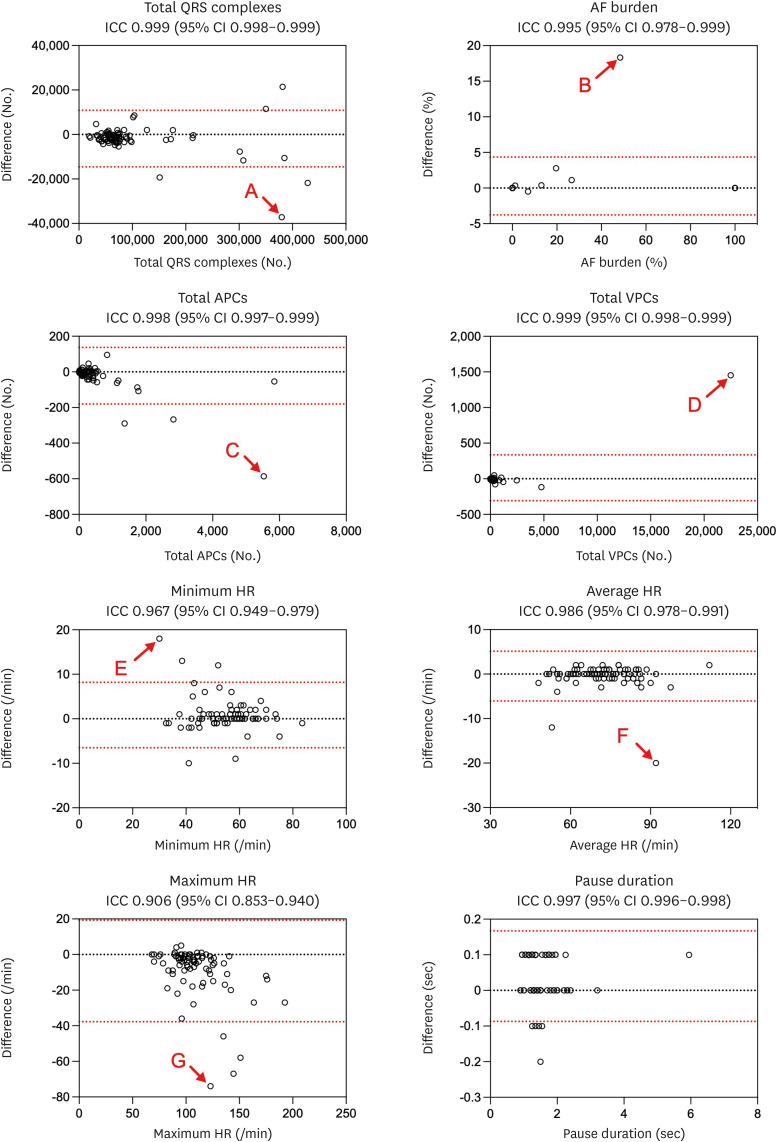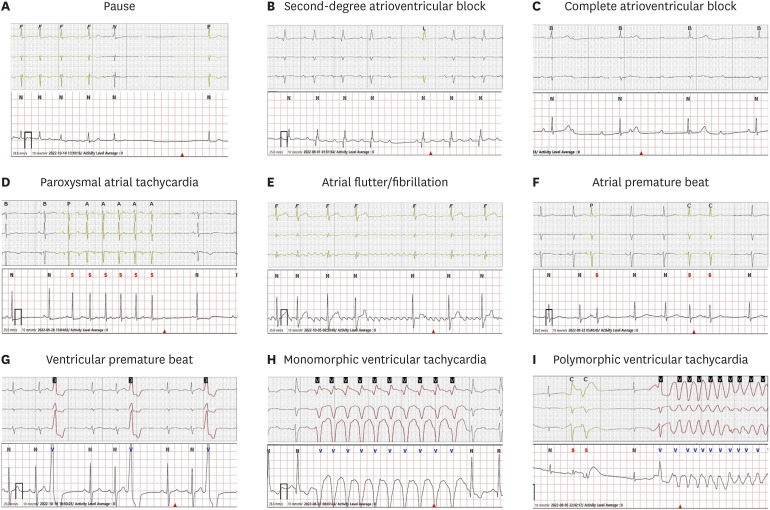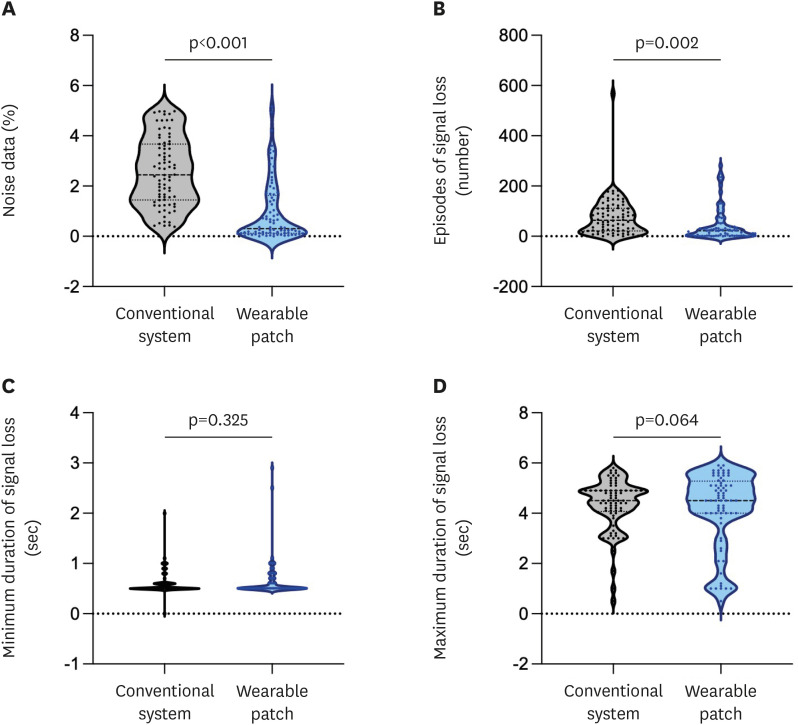Korean Circ J.
2024 Mar;54(3):140-153. 10.4070/kcj.2023.0252.
Comparison of Novel Telemonitoring System Using the Single-lead Electrocardiogram Patch With Conventional Telemetry System
- Affiliations
-
- 1Division of Cardiology, Department of Internal Medicine, Seoul National University Hospital, Seoul, Korea
- 2Department of Internal Medicine, Seoul National University College of Medicine, Seoul, Korea
- 3Seers Technology Co., Seongnam, Korea
- 4Division of Cardiology, Department of Internal Medicine, Hallym University Medical Center, Anyang, Korea
- KMID: 2554142
- DOI: http://doi.org/10.4070/kcj.2023.0252
Abstract
- Background and Objectives
Although a single-lead electrocardiogram (ECG) patch may provide advantages for detecting arrhythmias in outpatient settings owing to user convenience, its comparative effectiveness for real-time telemonitoring in inpatient settings remains unclear. We aimed to compare a novel telemonitoring system using a single-lead ECG patch with a conventional telemonitoring system in an inpatient setting.
Methods
This was a single-center, prospective cohort study. Patients admitted to the cardiology unit for arrhythmia treatment who required a wireless ECG telemonitoring system were enrolled. A single-lead ECG patch and conventional telemetry were applied simultaneously in hospitalized patients for over 24 hours for real-time telemonitoring. The basic ECG parameters, arrhythmia episodes, and signal loss or noise were compared between the 2 systems.
Results
Eighty participants (mean age 62±10 years, 76.3% male) were enrolled. The three most common indications for ECG telemonitoring were atrial fibrillation (66.3%), sick sinus syndrome (12.5%), and atrioventricular block (10.0%). The intra-class correlation coefficients for detecting the number of total beats, atrial and ventricular premature complexes, maximal, average, and minimal heart rates, and pauses were all over 0.9 with p values for reliability <0.001. Compared to a conventional system, a novel system demonstrated significantly lower signal noise (median 0.3% [0.1–1.6%] vs. 2.4% [1.4–3.7%], p<0.001) and fewer episodes of signal loss (median 22 [2–53] vs. 64 [22–112] episodes, p=0.002).
Conclusions
The novel telemonitoring system using a single-lead ECG patch offers performance comparable to that of a conventional system while significantly reducing signal loss and noise.
Figure
Reference
-
1. Drew BJ, Califf RM, Funk M, et al. Practice standards for electrocardiographic monitoring in hospital settings: an American Heart Association scientific statement from the Councils on Cardiovascular Nursing, Clinical Cardiology, and Cardiovascular Disease in the Young: endorsed by the International Society of Computerized Electrocardiology and the American Association of Critical-Care Nurses. Circulation. 2004; 110:2721–2746. PMID: 15505110.2. Sandau KE, Funk M, Auerbach A, et al. Update to practice standards for electrocardiographic monitoring in hospital settings: a scientific statement from the American Heart Association. Circulation. 2017; 136:e273–e344. PMID: 28974521.3. Sandroni C, Nolan J, Cavallaro F, Antonelli M. In-hospital cardiac arrest: incidence, prognosis and possible measures to improve survival. Intensive Care Med. 2007; 33:237–245. PMID: 17019558.4. Svennberg E, Tjong F, Goette A, et al. How to use digital devices to detect and manage arrhythmias: an EHRA practical guide. Europace. 2022; 24:979–1005. PMID: 35368065.5. Sandberg EL, Halvorsen S, Berge T, et al. Fully digital self-screening for atrial fibrillation with patch electrocardiogram. Europace. 2023; 25:euad075. PMID: 36945146.6. Manninger M, Zweiker D, Svennberg E, et al. Current perspectives on wearable rhythm recordings for clinical decision-making: the wEHRAbles 2 survey. Europace. 2021; 23:1106–1113. PMID: 33842972.7. Kwon S, Lee SR, Choi EK, et al. Comparison between the 24-hour Holter test and 72-hour single-lead electrocardiogram monitoring with an adhesive patch-type device for atrial fibrillation detection: prospective cohort study. J Med Internet Res. 2022; 24:e37970. PMID: 35532989.8. Barrett PM, Komatireddy R, Haaser S, et al. Comparison of 24-hour Holter monitoring with 14-day novel adhesive patch electrocardiographic monitoring. Am J Med. 2014; 127:95.e11–95.e17.9. Liu CM, Chang SL, Yeh YH, et al. Enhanced detection of cardiac arrhythmias utilizing 14-day continuous ECG patch monitoring. Int J Cardiol. 2021; 332:78–84. PMID: 33727122.10. Kim JY, Oh IY, Lee H, et al. The efficacy of detecting arrhythmia is higher with 7-day continuous electrocardiographic patch monitoring than with 24-h Holter monitoring. J Arrhythm. 2023; 39:422–429. PMID: 37324764.11. Bouzid Z, Al-Zaiti SS, Bond R, Sejdić E. Remote and wearable ECG devices with diagnostic abilities in adults: a state-of-the-science scoping review. Heart Rhythm. 2022; 19:1192–1201. PMID: 35276320.12. Bland JM, Altman DG. Statistical methods for assessing agreement between two methods of clinical measurement. Lancet. 1986; 1:307–310. PMID: 2868172.13. Bansal A, Joshi R. Portable out-of-hospital electrocardiography: a review of current technologies. J Arrhythm. 2018; 34:129–138. PMID: 29657588.14. Al-Alusi MA, Ding E, McManus DD, Lubitz SA. Wearing your heart on your sleeve: the future of cardiac rhythm monitoring. Curr Cardiol Rep. 2019; 21:158. PMID: 31768764.15. Leclercq C, Witt H, Hindricks G, et al. Wearables, telemedicine, and artificial intelligence in arrhythmias and heart failure: proceedings of the European Society of Cardiology Cardiovascular Round Table. Europace. 2022; 24:1372–1383. PMID: 35640917.16. Pevnick JM, Birkeland K, Zimmer R, Elad Y, Kedan I. Wearable technology for cardiology: an update and framework for the future. Trends Cardiovasc Med. 2018; 28:144–150. PMID: 28818431.17. Ackermans PA, Solosko TA, Spencer EC, et al. A user-friendly integrated monitor-adhesive patch for long-term ambulatory electrocardiogram monitoring. J Electrocardiol. 2012; 45:148–153. PMID: 22153334.18. Ramkumar S, Nerlekar N, D’Souza D, Pol DJ, Kalman JM, Marwick TH. Atrial fibrillation detection using single lead portable electrocardiographic monitoring: a systematic review and meta-analysis. BMJ Open. 2018; 8:e024178.19. Kwon S, Lee SR, Choi EK, et al. Validation of adhesive single-lead ECG device compared with Holter monitoring among non-atrial fibrillation patients. Sensors (Basel). 2021; 21:3122. PMID: 33946269.
- Full Text Links
- Actions
-
Cited
- CITED
-
- Close
- Share
- Similar articles
-
- A Study on the Implementation of Medical Telemetry Systems Using Wireless Public Data Network Medical Telemetry System
- Development of Home Health Monitoring System using Digital Telemetry
- Development of Biosignal Telemonitoring System Based on HL7 and MFER Standard
- Clinical application of tape-recorder and telemetry system for analysis of fetal heart rate
- Evaluation of the Diagnostic Performance and Efficacy of Wearable Electrocardiogram Monitoring for Arrhythmia Detection after Cardiac Surgery

